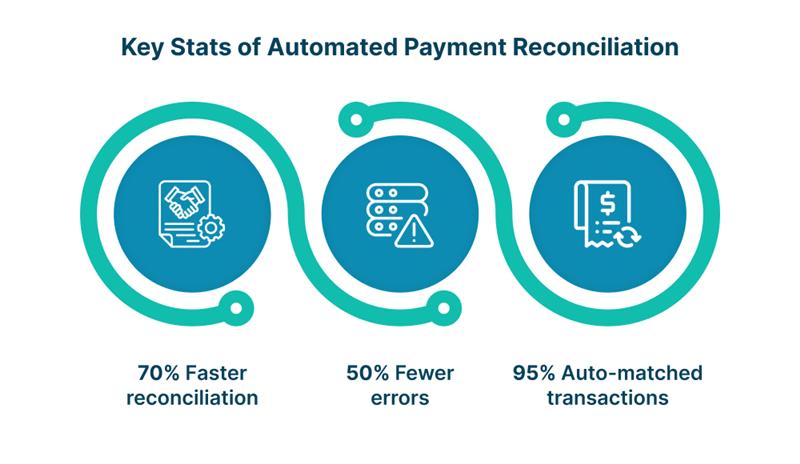Payment Reconciliation
Delayed Settlements, Faster Churn: Why Speed in Reconciliation Matters More Than Ever
Discover how automation accelerates reconciliation, reduces errors, and helps businesses manage rising transaction volumes and compliance demands in 2025.

Amrit Mohanty
Jul 8, 2025 (Last Updated: Nov 17, 2025)

Digital payment platforms, such as UPI, are driving the volume of financial transactions up at an unprecedented rate. UPI processed a record 16.73 billion transactions in December 2024 alone, reflecting the massive shift toward cashless economies. As a result, it has increased the reconciliation workload for banks and financial institutions.
The delays in settlements and reconciliation not only strain working capital but also increase operational risks. 82% of contractors are now waiting over 30 days for payments, up from 49% two years ago.
To manage this surge in volume, finance teams need to adopt intelligent automation. This approach can reduce reconciliation time by 70% and errors by 50%, enabling the teams to handle the data efficiently and maintain customer trust. Expediting reconciliation is essential to preventing transaction churn and protecting margins in today’s high-velocity financial operations.
Understanding Reconciliation and Settlements
Account reconciliation is the process of comparing a company’s internal financial records, such as ledgers and invoices, with external documents such as bank statements. This process is critical for identifying discrepancies, preventing fraud, and maintaining financial integrity. Settlement is the process by which a financial transaction is completed and finalized. It involves the actual transfer of funds from the payer’s account to the payee’s account.
According to the Association of Certified Fraud Examiners, 9% of reported fraud cases in 2022 involved financial statement fraud, highlighting the importance of reconciliation in fraud detection. Reconciliation usually involves gathering records, matching transactions, investigating variances, and documenting the findings.
The Problem with Delayed Settlements

A delay in settlements disrupts the financial close process, causing inaccuracies and extending the financial close cycles. On average, organizations take 10 days to complete month-end closes, but many finance teams struggle to meet the deadlines due to issues in manual reconciliation.
Gartner reports that 55% of finance operations aim for a touchless financial close by 2025, targeting faster, real-time closes to enhance reliable reporting. Delays also increase the operational workload and risk, ultimately affecting customer satisfaction and partner retention.
Why Speed in Reconciliation Matters More Than Ever
Speed in reconciliation is necessary for regulatory compliance and fraud risk reduction. Automated reconciliation tools reduce unmatched transactions to less than 2%, despite dealing with complex and fragmented data sources. They provide real-time visibility and audit-ready workflows.
According to Deloitte, robotic process automation (RPA) reduces manual reconciliation effort by 50-70% and improves variance detection and resolution.
Faster reconciliation enables you to comply with strict regulations, reducing audit penalties and damage to your reputation. Moreover, continuous reconciliation models help detect anomalies early and avoid fraud risks that account for 9% of financial statement fraud cases globally.
Strategies to Expedite Reconciliation and Settlements
Automation is expediting reconciliation by enabling finance teams to auto-match up to 95% of the transactions, therefore drastically reducing manual effort and errors.
According to Gartner (2023), automation can cut reconciliation time by up to 80%, accelerating month-end closes and improving accuracy.
RPA and AI tools quickly gather data from multiple sources, identify discrepancies, and address exceptions. As a result, reconciliation becomes a continuous process rather than a scheduled, batch-driven task. Workato notes that reconciliation processing time can drop by 60-80%.
In Deloitte’s research, a financial services executive shared that by utilizing multiple intelligent automation tools, their organization achieved a cost reduction of over 70% in a targeted area. Leveraging these technologies is becoming essential to handle growing transaction volumes while maintaining financial control.
Real-World Examples
Several industries have gained significant benefits from faster reconciliation cycles through automation.
Pembina, a North American energy transport provider, implemented BlackLine and consolidated 6,500 accounts, reducing the number of reconciliations to fewer than 1,000.
Coca‑Cola’s finance operations consolidated over 50,000 GL accounts across 272 legal entities. By implementing BlackLine, they gained a 56% reduction in the FTEs working on reconciliations and saved US $600,000 annually.
A tier‑two asset manager moved cash and position reconciliations in-house using Duco’s SaaS platform, giving their team total control and flexibility. They retired the on‑premise legacy system and the outsourced provider, gaining major efficiency improvements.
These improvements not only boost operational efficiency but also enhance compliance and financial transparency, helping organizations manage the increasing transaction volumes and regulatory demands.
Balancing Speed with Accuracy
It is essential to balance speed with accuracy in reconciliation to maintain financial integrity and compliance. While automation can reduce manual effort and fast-track processes, human intervention remains necessary to interpret exceptions and ensure compliance with regulations.
Companies achieving less than 2% unmatched transactions do so by combining AI-driven automation with skilled finance teams well-versed in evolving compliance requirements. Continuous investment in staff training and clear reconciliation processes helps prevent costly errors, ensures audit readiness, and maintains fast, accurate financial closes.
Conclusion
Delayed settlements result in faster customer and partner churn by weakening trust and disrupting the cash flow. From 2016 to 2021, daily B2B payments surged 41%. As transaction volumes grow, keeping pace with manual reconciliation becomes complicated, causing prolonged close cycles and errors.
Automation reduces reconciliation time and errors, delivering real-time visibility and compliance benefits. With 97% of mid-sized enterprises facing increased data complexity, adopting AI-powered payment reconciliation tools is becoming critical to maintain margins and a competitive advantage in 2025.

